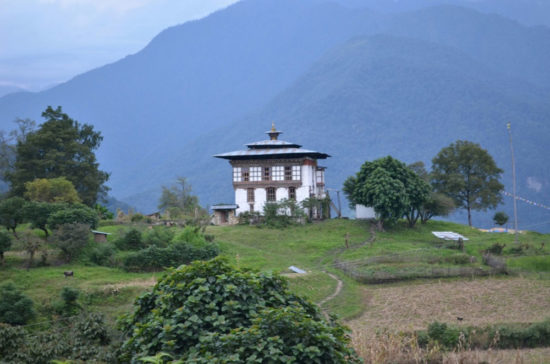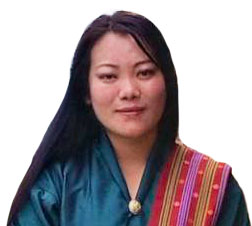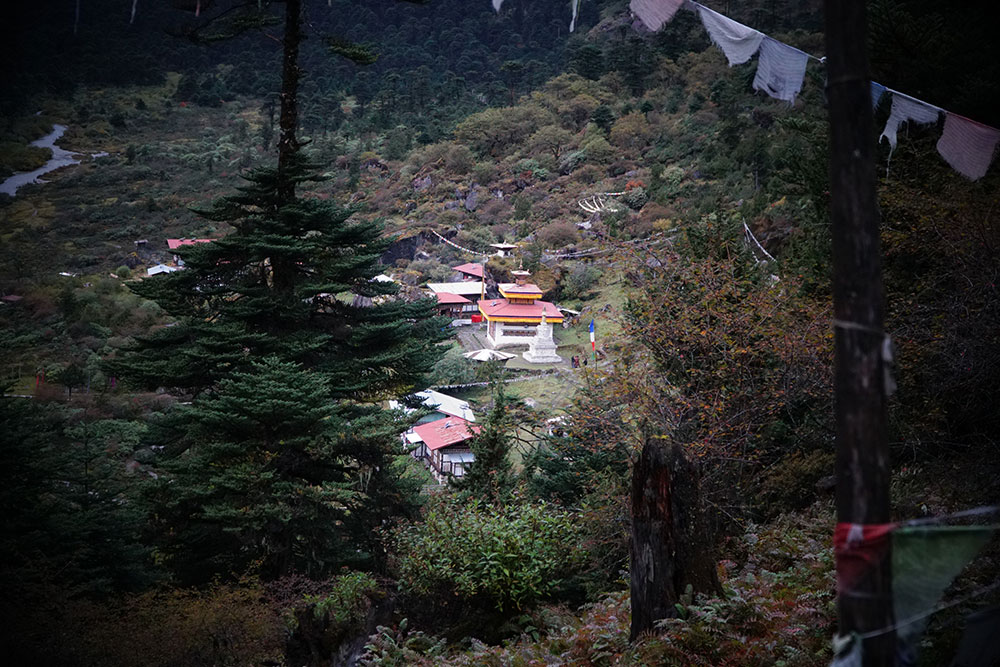If you believe traveling sets your mind free and brings a celestial joy, Lhuentse awaits you!
Lhuentse lies in the northeastern corner of Bhutan and is the ancestral home of our monarchs. Lhuentse is also popular among the domestic tourists for the authentic spiritual and cultural experiences it offers to the visitors.
Lhuentse Dzong and Lekpagang gi Tshenden
Lhuentse Dzong, popularly known as Lhuendruptse gi Dzongchen or Lhuendrup Rinchentse is a well-known historic site. It was initially built on the site where Yongzin Ngagi Wangchuk was in 1552 as a Dzongchung-small dzong. Later on, Trongsa Penlop Minjur Tempa built the current Dzong. It has many sacred relics including the Tshepamay statue that was once kept in Kidlung Lhakhang. Annually the Dzongkhag Administration and Dratshang organize Tshempay Tshechu, where people get the blessing of longevity from the statue. Today it serves as the office for the district administrative and religious body, housing many sacred relics installed by Desi Tenzin Rabgay. The fortress sits atop a hill overlooking the majestic Kurichhu river and is the venue for the Lhuentse festival. The Dzong’s most sacred artifact is the bronze statue of Tshepamey, which was found in the fishing net of a local fisherman.
Another notable attraction is Lekpagang gi Tshenden (cypress trees of Lekpagang) opposite to Lhuntse Dzong, which is believed to release smoke once every year before we celebrate Thrue Bab (Blessed Rainy Day). It is said to be the oldest of all the cypress trees in Bhutan as its story can be traced back to the 8th century when Khikha Rathoed was exiled from Khenpajong to Bumthang.
Singye Dzong
Singye Dzong is one of the famous sacred places related to Guru Rinpoche in the history of Bhutan. Every year hundreds and thousands of domestic tourists visit Singye Dzong. It is located three days’ walk away from Khoma Gewog. It falls under Bumdeling Wildlife Sanctuary sharing border with China. The closest communities to Singye Dzong are Khomagang and Denchung villages. Currently, the area has a mediation center that accommodates 12 monks in a three-year retreat, and two main monasteries are Gawa Dzong and Singye Dzong.
The entire journey has wooden bridges, a wide footpath, signage, and resting places. One is accompanied throughout the journey by the swift-flowing river that starts from one of the Singye Dzong lakes. When we are about to reach the destination, the vegetation changes with view of tall rocky mountains, small shrubs, yak grazing in the meadows, icy crystal clear streams, flowers, birds, and medical herbs. It is a breathtaking moment for anyone who makes it there.
Singye Dzong has eight sacred rocky hill Dzongs and many imprints of Guru Rinpoche’s and Dakini Yeshey Tshogyel’s bodies and hidden termas are still visible to visitors. There are four major lakes known as Yumtharma, Tshona, Tshokhar, and Terdha Latsho. Bhutanese devotees across the country dream of visiting the Singye Dzong at least once in their life for this divine experience and belief of cleansing their sins and to make their afterlife journey peaceful. The daggers discovered by Guru Rinpoche are still viewed as the main relics of Singye Dzong.
Rinchen Bumpa and Kuenzangling Lhakhang
Rinchen Bumpa (vase of the jewels) is also a prominent domestic tourist attraction in Lhuentse and is located in Kurtoed Gewog. It takes six hours uphill walk from Kuenzangling Lhakhang. The sacred site manuscript mentions that it was prophesied by Ratna Lingpa and later blessed by Longchenpa. Locals believe it is a place where the beings with karmic connection had attained accomplishment, a place where devotees make offerings. Among many sacred relics, the most fascinating is a large rock slab on which visitors can eyewitness holy letters when the first of the sun falls on the rock. It remains for an hour and fades away gradually. Devotees stay overnight to witness the sacred holy letters. Other significant places related to Guru Rinpoche, Khandro Yeshey Tshogyal and Khandro Tashi Kedron can also be seen.
Kunezangling Lhakhang is located on the base of Rinchen Bumpa, which is blessed by Kuenkhan Longchen Rabjam. The main sacred objects include a statue of Buddha, Guru Rinpoche, and Zambala. Inside the temple, one can see the footprints of Kuenkhan Longchen Rabjam on the rock where he meditated.
Dungkar Naktshang and Jigme Namgyal Naktshang
Dungkar Naktshang, the ancient home of the Dungkar Chojie and the ancestral home of the Wangchuck Dynasty, is located near Jigme Namgyal Naktshang on the Dungkar shape land. Pila Goenpo Wangyel married Sonam Pelzom of Jangsa and gave birth to Jigme Namgyal, the father of the first King of Bhutan. The 16th century magnificent Naktshang, where Jigme Namgyal was born still stands tall today and it is located 40 KM drive away from Lhuentse Dzong. In 1825, a boy called Jigme Namgyal was born in Dungkar, Kurtoed Gewog, and started the Wangchuck Dynasty. He traveled toward Trongsa in search of his destiny to become Trongsa Penlop. Later, his son Druk Gyalpo Ugyen Wangchuck became the first King of Bhutan. These two ancestral home of the monarchs are the historical and architectural feast for all visitors.

Dungkar Naktshang
Lhuentse Dzongkhag witnesses increasing number of visitors all season every year. Most visit the district for spiritual pilgrimage, while some for nature, culture and exotic textile. Lhuentse dzongkhag is a perfect model of ecotourism destination in Bhutan with rich biodiversity, living culture and vibrant community. Lhuentse has a huge potential for high value tourism experiences for all.

Tshewang Zangmo is working as Asst. Economic Development Officer under Lhuentse Dzongkhag Administration. She graduated from Sherubtse College studying B.A. Dzongkhag and English. She loves travelling, photography, reading, writing free verse and painting. She believes mindfulness at workplace is key to success.

This series is sponsored by Ecotourism Project “Mainstreaming Biodiversity Conservation into the Tourism Sector in Bhutan” funded by GEF-UNDP through Tourism Council of Bhutan, RGoB.


